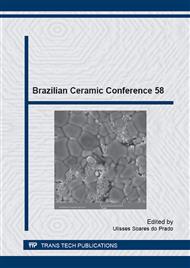p.131
p.137
p.143
p.149
p.155
p.161
p.167
p.172
p.181
High Energy Milling of Alumina Synthesized by Combustion Reaction Using a Vertical Shaft Attritor Mill: Influence of the Milling Time Length
Abstract:
Among the vast applications in which the α-alumina can apply, the literature has reported researches which aim to achieve better features of these materials varying the obtainment methodology and some post-obtainment techniques. Thus, this paper aims to evaluate how different milling time lengths of 15, 30, 45 and 60 minutes alter the structure and morphology of α-alumina powders synthesized by combustion reaction. The time and temperature of the combustion reaction were evaluated during the synthesis of the alumina. The samples of non-milled and milled alumina were characterized by XRD and particle size analysis. The results showed that the maximum achieved temperature of reaction was 598°C. The milling time length variation did not alter the stable α-Al2O3 majority crystal phase present in all samples. The average particle diameter was reduced from 23.3 to 10.5 μm comparing the non-milled and the sample milled for 60s.
Info:
Periodical:
Pages:
155-160
Citation:
Online since:
June 2015
Keywords:
Price:
Сopyright:
© 2015 Trans Tech Publications Ltd. All Rights Reserved
Share:
Citation:


